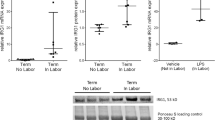Abstract
Matrix metalloproteinase-1 (MMP-1) and neutrophil elastase are proteolytic enzymes involved in tissue remodeling, but a role for them as uterotonic agents has not been considered. However, both these proteases activate protease-activated receptor 1 (PAR-1) that mediates thrombin-induced contractions. Matrix metalloproteinase-1 and elastase are products of neutrophils that infiltrate intrauterine tissues at the time of labor, so we tested the hypothesis that these proteases might be novel uterotonic agents acting via PAR-1. Decidual tissue was collected from fetal membranes of term not-in-labor (TNL), term labor (TL), and preterm labor (PTL) women and analyzed for gene and protein expression of MMP-1 and neutrophil elastase. Contractile effects of MMP-1 and elastase were tested with uterine strips of day 19 and 20 gestation rats. Expression of MMP-1 and neutrophil elastase was increased in TL and PTL as compared to TNL. Expression of both the pro- and active enzymes of MMP-1 increased progressively from TNL to TL to PTL. Tumor necrosis factor-α, a neutrophil product, increased MMP-1 in decidual and myometrial cells. Both MMP-1 and elastase stimulated strong contractions of myometrial strips, which were prevented by inhibition of PAR-1 and inhibition of inositol trisphosphate receptor or calcium channel blockade. Indomethacin did not prevent proteaseinduced contractions. These data suggest that MMP-1 and neutrophil elastase may be important but heretofore unrecognized players in stimulating uterine contractions at the time of labor, and they may explain why indomethacin delays, but does not prevent, PTL because indomethacin inhibits the prostaglandin component but not the protease component of labor.
Similar content being viewed by others
References
Maymon E, Romero R, Pacora P, et al. Evidence for the participation of interstitial collagenase (matrix metalloproteinase 1) in preterm premature rupture of membranes. Am J Obstet Gynecol. 2000;183(4):914–920.
Strauss JF III. Extracellular matrix dynamics and fetal membrane rupture. Reprod Sci. 2013;20(2):140–153.
Wang H, Ogawa M, Wood JR, et al. Genetic and epigenetic mechanisms combine to control MMP1 expression and its association with preterm premature rupture of membranes. Hum Mol Genet. 2008;17(8):1087–1096.
Challis JR, Lockwood CJ, Myatt L, Norman JE, Strauss JF III, Petraglia F. Inflammation and pregnancy. Reprod Sci. 2009; 16(2):206–215.
Shynlova O, Lee YH, Srikhajon K, Lye SJ. Physiologic uterine inflammation and labor onset: integration of endocrine and mechanical signals. Reprod Sci. 2013;20(2):154–167.
Thomson AJ, Telfer JF, Young A, et al. Leukocytes infiltrate the myometrium during human parturition: further evidence that labour is an inflammatory process. Hum Reprod. 1999;14(1):229–236.
Ahn HS, Chackalamannil S, Boykow G, Graziano MP, Foster C. Development of proteinase-activated receptor 1 antagonists as therapeutic agents for thrombosis, restenosis and inflammatory diseases. Curr Pharm Des. 2003;9(28):2349–2365.
Trivedi V, Boire A, Tchernychev B, et al. Platelet matrix metalloprotease-1 mediates thrombogenesis by activating PAR1 at a cryptic ligand site. Cell. 2009;137(2):332–343.
Elovitz MA, Ascher-Landsberg J, Saunders T, Phillippe M. The mechanisms underlying the stimulatory effects of thrombin on myometrial smooth muscle. Am J Obstet Gynecol. 2000;183(3):674–681.
Elovitz MA, Saunders T, Ascher-Landsberg J, Phillippe M. Effects of thrombin on myometrial contractions in vitro and in vivo. Am J Obstet Gynecol. 2000;183(4):799–804.
Phillippe M, Elovitz M, Saunders T. Thrombin-stimulated uterine contractions in the pregnant and nonpregnant rat. J Soc Gynecol Investig. 2001;8(5):260–265.
Shintani Y, Hirano K, Nishimura J, Nakano H, Kanaide H. Enhanced contractile response to thrombin in the pregnant rat myometrium. Br J Pharmacol. 2000;131(8):1619–1628.
Suzuki T, Moraes TJ, Vachon E, et al. Proteinase-activated receptor-1 mediates elastase-induced apoptosis of human lung epithelial cells. Am J Respir Cell Mol Biol. 2005;33(3):231–247.
Coughlin SR. Thrombin signalling and protease-activated receptors. Nature. 2000;407(6801):258–264.
Coughlin SR. Protease-activated receptors in vascular biology. Thromb Haemost. 2001;86(1):298–307.
Coughlin SR. Protease-activated receptors in hemostasis, thrombosis and vascular biology. J Thromb Haemost. 2005;3(8):1800–1814.
Smith R. Parturition. N Engl J Med. 2007;356(3):271–283.
Lockwood CJ, Arcuri F, Toti P, et al. Tumor necrosis factor-alpha and interleukin-1beta regulate interleukin-8 expression in third trimester decidual cells: implications for the genesis of chorioamnionitis. Am J Pathol. 2006;169(4):1294–1302.
Condon J, Yin S, Mayhew B, Word RA, Wright WE, Shay JW. Telomerase immortalization of human myometrial cells. Biol Reprod. 2002;67(2):506–514.
Anderson CD Jr, Kendig DM, Al-Qudah M, Mahavadi S, Murthy KS, Grider JR. Role of various kinases in muscarinic M3 receptor-mediated contraction of longitudinal muscle of rat colon. J Smooth Muscle Res. 2014;50:103–119.
Mousa AA, Cappello RE, Estrada-Gutierrez G, et al. Preeclampsia is associated with alterations in DNA methylation of genes involved in collagen metabolism. Am J Pathol. 2012;181(4):1455–1463.
Poole RM, Elkinson S. Vorapaxar: first global approval. Drugs. 2014;74(10):1153–1163.
O’Sullivan CJ, Allen NM, O’Loughlin AJ, Friel AM, Morrison JJ. Thrombin and PAR1-activating peptide: effects on human uterine contractility in vitro. Am J Obstet Gynecol. 2004;190(4):1098–1105.
Author information
Authors and Affiliations
Corresponding author
Rights and permissions
About this article
Cite this article
Walsh, S.W., Nugent, W.H., Solotskaya, A.V. et al. Matrix Metalloprotease-1 and Elastase Are Novel Uterotonic Agents Acting Through Protease-Activated Receptor 1. Reprod. Sci. 25, 1058–1066 (2018). https://doi.org/10.1177/1933719117732162
Published:
Issue Date:
DOI: https://doi.org/10.1177/1933719117732162



